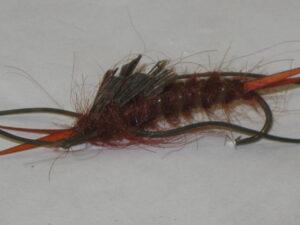This post was last updated on February 11th, 2023 at 04:48 pm
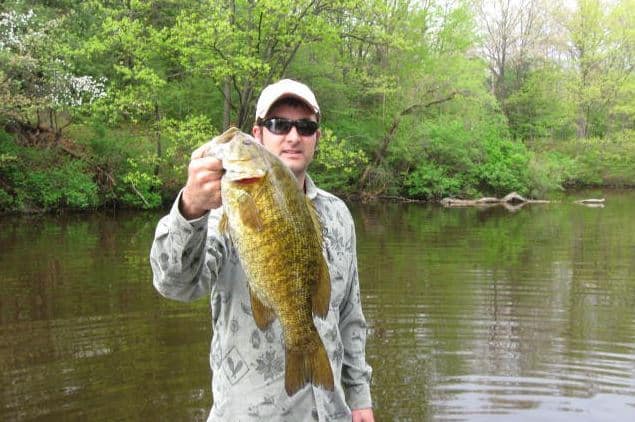
Fly fishing For Smallmouth and Largemouth Bass
I have spent a large part of my life bass fishing, and I can say for certain that I have had almost too much fun at times fishing for them with a fly rod. I recall days where the bass were hitting streamers so well, that I started feeling a little guilty about it.
The ways to fish for bass with a fly will vary depending on the time of year, so this post will help you out with fly choices and presentations that will allow you to haul them to the boat all year long. I will break them down by the seasons for easy digestion.
The largemouth is the most widespread bass species in the US, and I am guessing that is what most people think of when they hear the word bass. The largemouth likes warmer water than the smallmouth bass, so they will usually not be caught in the exact same areas.
In the below article, I will be thoroughly covering the habits of both of these species in relation to fly fishing techniques, fishing locations and presentations.
Fly Rods For Bass
My first choice would be a 6 weight rod with weight forward line, this rod will be good for trout and bluegill as well as small northern pike. If your goal is to fish exclusively for bass you could consider a 7 weight as well.
The larger rod will help you cast large wind resistant flies into the wind easily. They make fly rods especially for bass such as the Sage BASS II Fly Rod.
Early Spring Fly fishing for Bass
Bass will begin moving into the warmest areas of lakes shortly after ice out. They will ideally move into bays, cuts and canals seeking the slightly higher water temperature of these areas. Chances are they will be found most active in shallow areas that are isolated away from the main lake.
Since the largemouth’s wont show signs of spawing until the temperature is above 52 degrees, they will be available to catch “pre-spawn” for quite some time. The window for smallmouth bass is a little bit smaller, but the fishing style is basically the same this time of year.
During this early spring period, you will not be able to catch bass using the large poppers or very fast moving presentations. These warm water fish will be too lethargic to come to the surface to feed, you will have to use streamers or large nymph patterns to catch them. My advice is to fly fish the shallow water with medium sized streamers (2-3 inches) and strip them SLOW.
These flies should have very little if any weight to them, because you are fishing shallow and the lack of weight should keep them suspended, or atleast slowly sinking and visible to the fish. You might not even feel the hit during a super slow strip, it will be more like extra weight on your line until the hookset.
Fly Fishing For Bass – I Catch a Couple Pretty Nice Ones on Camera in this Fast paced Video from Flyfishingisfun on Vimeo.
Early Spring Smallmouth Strategies
I have had some tremendous days fishing streamers fairly fast for smallmouth in the pre-early spawn time of year. They will often get aggressive in the areas where they plan to spawn before they actually begin making nests. If you know of a small canal where smallmouth generally spawn, these areas can get nutty this time of year.
A few key areas to look are:
- Shallow rocky or gravel areas in close proximity to deep water. Smallmouth prefer to have deep water near them at almost all times, while the largemouth are much less picky about this.
- Lake points: A point is a natural area for bass to congregate and a top choice area for smallmouth to spend time during the pre-spawn and spawning season. Even a subtle point that is covered in sand will often hold bass. Try fly casting medium to fairly large streamers over these points for a potential “bronzeback”.
Check out this article on smallmouth bass fly fishing–it’s worth a read.
Spawning Bass
Bass of both major types will aggressively defend their beds from intruders, so casting a fly near the bed should get an immediate reaction. These fish will usually hit unless they have been pestered by someone else recently, or you are too close to their bed, making them skittish. They will usually stay on these beds even if you are in close proximity, but that doesn’t mean they will hit.
Fly fishing for bass during the spawn can be very effective, but keep in mind that these fish need to guard their eggs from other fish, so fish for them with discretion. A bass away from its spawning bed for even a short period will attract bluegills that will eagerly eat the eggs. Many people consider it unethical to fish for bass during this period, and personally I try to avoid catching active spawning fish.
Late Spring Early Summer Bass With a Flyrod
Post spawn bass fishing can often be tough. The fish seem to go into a recovery period after the spawn and don’t feed very heavily. However there are always fish to hook, because each and every bass acts a little different. Some bass will move directly into summer patterns, while many others will wallow in deep water or weedy drop offs becoming difficult to pinpoint. At this point in the spring you will find some largemouth in the weedy flats that they seem to love so much.
I would not go breaking out the huge bass poppers and frog patterns yet, but you could surely start to see a little success on these fly patterns. As for smallmouth I would look at the lake points as mentioned above and the traditional rocky areas of shoreline that I will outline in this next section.
Summertime Bass Fly Fishing Locations
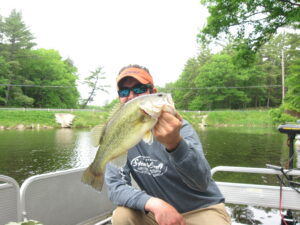 Summertime largemouth can be caught using standard popper and frog patterns in the lily pads, shallow weed flats and even patrolling shallows around docks and fallen timber. The optimal time to hook the most fish while flyfishing for bass is surely the early morning. The heat of the day can often make largemouth bass seek cover and make finding them a little more sporadic. whether you prefer to hook largemouth or smallmouth bass we all love to catch them on the surface.
Summertime largemouth can be caught using standard popper and frog patterns in the lily pads, shallow weed flats and even patrolling shallows around docks and fallen timber. The optimal time to hook the most fish while flyfishing for bass is surely the early morning. The heat of the day can often make largemouth bass seek cover and make finding them a little more sporadic. whether you prefer to hook largemouth or smallmouth bass we all love to catch them on the surface.
Topwater popper flies will work their absolute best during the first hours of daylight. During this time frame the fish are less cautious and easy to convince to come to the surface to eat your flies. Both bass species are easily found in the early morning shallow areas cruising for food. If you are primarily targeting smallmouth remember they will want deep water nearby, so keep that in mind when choosing your areas.
Summertime Smallmouth bass locations: These will typically include rocky areas of shoreline with a fast drop off to deep water in close proximity. If you can think of a shoreline covered with rocks with an old river channel nearby, you might have a great place to flyfish for summer smallmouth bass. This species will also enjoy rivers and areas of high amounts of current in lakes where rivers pour in.
Bass Fly Patterns
Great bass flies can come in any color, because many fish will all crave black flies; while another lake nearby might have bass with a fetish for green flies on any given day. In light of this I will refrain from offering too many of my favorite fly colors and try to stick with the patterns only. Keep in mind you can’t go wrong with natural colors, because all bass love crawdads, so brown flies will always be a productive color. I have also found largemouth in my area to have a particular fondness for all black streamers throughout much of the year.
Bass Poppers
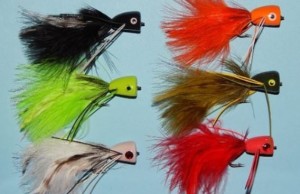 We all know the idea behind bass poppers. A strip of your fly line means the popper will make a nice “pop” on the surface of the water attracting bass from all directions. The bass feel the vibrations through the water using their lateral line sensitivity. These popper patterns can be fished fast or slow, depending on the aggression level of the fish that day.
We all know the idea behind bass poppers. A strip of your fly line means the popper will make a nice “pop” on the surface of the water attracting bass from all directions. The bass feel the vibrations through the water using their lateral line sensitivity. These popper patterns can be fished fast or slow, depending on the aggression level of the fish that day.
Streamers
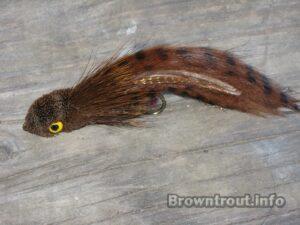
Flies such as this streamer will work well and probably be your number one “go to” flies for bass fishing. The one shown in the image works really well for both trout fishing and bass. It does a good job of looking like a crawdad and a dark colored minnow or baitfish.
Many bass streamers will be tied in a similar fashion with a deerhair head and a rabbit strip tail. You can successfully fly fish for bass using a sink tip, or even a full sink fly line using these flies.
Large Nymphs
On days where bass won’t respond to poppers or streamers, you could always consider down sizing to a stonefly pattern similar to the image (left).
These do a good job at representing damselfly nymphs and even dragonfly nymphs. Slow stripping this through an area with bass will surely provoke a strike.
There are a lot a variables to take into consideration while fly fishing for bass. There should be enough information here to get you started out. Even if you are a seasoned veteran fly fishing bass angler, I hope you were able to find some useful information here. Please leave your own bass fishing tips in the comments section below.

